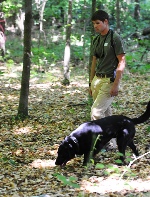
EcoDogs Sniff Out Endangered Species
Auburn University researchers can document the location and number of rare animals through a new program, EcoDogs: Detection Dogs for Ecological Research.
The dogs are trained to find where the animals have been by finding their excrement.
Todd Steury, assistant professor of wildlife ecology in the School of Forestry and Wildlife Sciences, started a program to study the“greatest conservation need” species.
“Alabama is home to 117 endangered species, which is third in the United States behind Hawaii and California, and numerous other species are at risk,” Steury said. “But little is known about these species, including where they are located, the habitats they occupy, and how many individuals of a species exist.”

Auburn University handler Bart Rogers works with Bishop, a 3-year-old black Labrador retriever.
Sophie, a 15-month-old black Labrador retriever, is trained to find scat from eastern spotted skunks, while Bishop, a 3-year-old black Labrador retriever, is trained to find scat from striped skunks. Both can also detect scat from black bears. The program recently added five new dogs.
“We are especially interested in the eastern spotted skunk,” Steury said. “It is very small like a squirrel and is very susceptible to predators. Over the past two years, we have taken more than 600,000 photos with game cameras and we only got two photos of eastern spotted skunks. ”
The goal, he says, is to find populations large enough to study with additional techniques such as trapping and attaching radio transmitter collars.
“We want to find out what is reducing the populations,” he said. “Is it disease? Is it predators? We need to know the reproduction rates. We then can address issues that cause animals to become endangered.”
EcoDogs, which began one year ago, is the only program of its kind in the Southeast and is one of four such efforts in the United States. Two are located in Washington state and one in Montana. EcoDogs is a collaborative project between Auburn’s School of Forestry and Wildlife Sciences and the College of Veterinary Medicine’s Animal Health Performance Program, which includes the Canine Detection and Research Institute and the Sports Medicine Program.
“The dogs are housed at the veterinary college where we provide care and prepare them for this type of work,” said Rob Gillette, director of the Animal Health Performance Program. “Our first priority is the dogs’ care and making sure they are in proper condition. The dogs love doing this.”
The college has handlers who train the dogs and accompany Steury and his graduate students to the research sites. This summer they will use the dogs to study black bears near Apalachicola, Fla., to learn more about human and bear interaction near new and proposed developments. Steury also wants to count black bears in the Mobile River Basin near Mobile.
The dogs, always teamed with a handler, can work up to four hours a day covering 12 miles in a zigzag pattern around the edges of a triangular area. Dogs usually detect the scat within 15 meters, sometimes up to 100 meters, and will sit down when they find the appropriate scent. A GPS collar allows trainers to keep up with the dog’s location and it records the dog’s path, which can be viewed later on a computer.
“If we see sudden or irregular paths on the GPS, this can indicate where the dog detected the scent of the scat,” Steury said.
He says the training time takes three to six weeks for the first scent and then a few days for additional scents. Samples of scat are collected from zoos and other wildlife organizations.
“We try to obtain scat from 10 to 20 individual animals of the species we want to study,” he said. “The dogs are exposed to those samples and rewarded for finding them. We also expose them to scat from other animals, such as deer, but we don’t reward them for finding those droppings. This teaches the dogs to ignore those scents.”